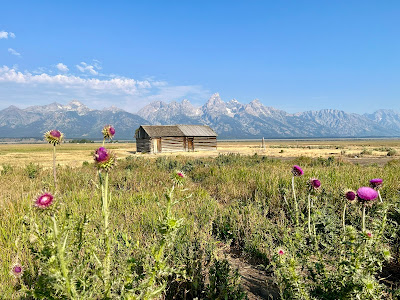I know that millions of people have likely taken photos of the Moulton Barns at the Grand Tetons. It's one of the iconic scenes featured on calendars and marketing materials. But that didn't keep me from wanting to get my own photos of the barn.
When we had arrived in the Grand Tetons the evening before, it was hazy and overcast. We had been to the Grand Tetons in 2011, and I remembered the beautiful blue skies framing the craggy, snow capped mountains.
 |
| A favorite photo from our 2011 trip |
 |
| Jenny Lake in 2011 |
 |
| Taken after riding the ski lift in 2011 |
And one more from 2011 ...
 |
| Also from 2011 |
The sun was trying to burn away some of the haze, but I must admit I was disappointed when we first arrived because I had those 2011 "snapshots" in my mind.
Still, even with the haze, there's a majesty to the area. You realize just how infinitesimal you are when looking at the mountains rising up from the plains ... when you see the vast lakes ... and when you view the deep canyons and valleys.
With the support and stewardship of many citizens locally and nationally, the Grand Teton National Park was established in 1929. John D. Rockefeller Jr. and his wife, Abby, first visited this area in 1926, beginning a family legacy of stewardship that continues even today. Strong supporters of national parks, they purchased more than 33,000 acres of the valley lands which were donated in 1949 - allowing Grand Teton to expand to its current boundary in 1950.
Their son Laurance S. Rockefeller continued this heritage by donating the Vernon Collection of American Indian Art and the JY Ranch, a family retreat for 75 years, to the park.
Powerful geologic forces - including earthquakes, volcanoes and glaciers - shaped the landscape. These mountain ranges formed in different ways, but ice-age glaciers scoured all of them and left behind lakes, U-shaped canyons, jagged ridges and outwash plains. (From a park sign)
Randy's favorite stop in our 2011 trip was Jenny Lake. It was definitely a different scene this time around, but we still thought it was a beautiful part of the park.
It was just another reminder of how clear the waters can be when fed by mountain snows.
Luckily, the next morning brought sunshine. Since we were leaving for home right after our trip to the barns, I know I was fortunate.
Leaders of the Church of Jesus Christ of Latter-day Saints - or Mormons - sent parties from the Salt Lake Valley to find new settlements to support their expanding population. Mormon settlers from Idaho first arrived to the Grand Tetons in the 1890s. The U.S. Post Office named this community Grovant, now known as Mormon Row.
The Homestead Act of 1862 promised 160 acres to anyone who built homes on the land and worked to improve the land. After five years of living there and working the land, the settler owned the land free and clear.
The 27 Mormon pioneer families picked this place for its relatively fertile soil, protection from winds by Blacktail Butte and access to the Gros Ventre River. Despite the harsh conditions of Jackson Hole, Mormon settlers succeeded in growing crops by using irrigation techniques they developed during the 1847 settlement of the Great Basin.
Mormon pioneers formed close-knit communities around their church and school, starkly contrasting with the pattern of isolation typical of many western households. Families cooperated with each other on large projects, from building barns to digging ditches. Women worked communally, assisting in neighbors' births and chores.
 |
| Yes, I know that the thistles are considered noxious weeds in Kansas. But they provided a pretty frame for the buildings and mountains. |
Mormon Row settlers dug ditches by hand or with teams of horses. They built levees and dikes to funnel water from central ditches to their fields. Working together, they built an intricate network of waterways between 1896 and 1937 to provide water for their crops.
The dwellings that have starred in so many tourists' photographs are what is left of the original 27 homesteads. They were added to the National Register of Historic Places in the 1990s.
While it would have been great to find more scenic spots in the Tetons when the sun was out, we were also both ready to head for home. We should have counted how many times we crossed the Continental Divide while on the trip. Maybe next time.
***
A note to anybody considering trips to National Parks:
- Plan ahead. At Glacier, the reservations open 4 months ahead of the date you'd like to visit. The passes go quickly in the nation's most popular parks.
- Get a National Parks pass. Randy got a Senior Pass when he turned 62. At the time, it was $60. Now it's $80, but it's worth every penny. You'd spend half that just for admission prices to get your car in one day at some of the national parks. (Ironically, he turned 62 two days too late. Before the price bump, Senior Passes were $20. But it's still a huge bargain.)
















So glad the sky cleared for you. Beautiful images of the old buildings.
ReplyDeleteI've just read that the Mormons have bought $300 million dollar property in in south west Qld. (Worral Creek)
Yes, I felt very fortunate, especially after the haze of the evening before.
Delete